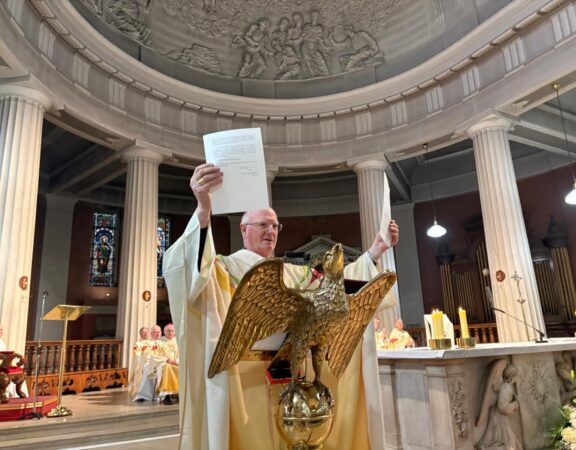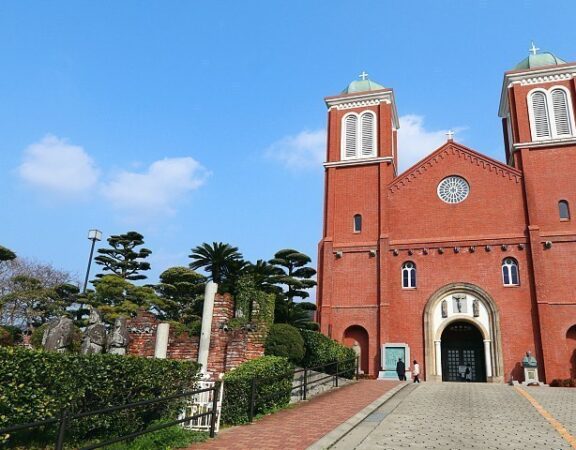Visit of the Statue of Our Lady of Fatima
SECOND SUNDAY OF LENT 2017
Homily notes of
Most Rev. Diarmuid Martin
Archbishop of Dublin
—————————————————————-
Pro-Cathedral Dublin, 12th March 2017
Introduction
We accompany this statue of Our Lady of Fatima on its journey around Ireland on the one hundredth anniversary of the apparitions. This statue helps us to reflect on the life of Mary herself, her joys and sorrows, her love for her son Jesus, and her compassionate love for all people.
Our Lady of Fatima brought her message to three young children. We ask her to guide the Church today. We recognize how Christians have failed in many ways to recognize and care for the weakest in society. We ask Mary to help us and our Church be ever true to Jesus and we turn to Mary who called us at Fatima to repentance as we recognize ourselves as sinners.
Homily
Today’s Gospel is a striking one. Last week on the first Sunday of Lent we encountered Jesus being tempted by the devil. Jesus is tested. The devil asks him to do certain things to show that he is the Son of God: “If you are the Son of God then….” Here we see already a first thing to note. There are different ways of looking at how we think the Son of God should act: the ways suggested by the devil or the way of Jesus himself as he rejects the temptations of the devil. It comes down to the fundamental question for us today: who is the God revealed in Jesus Christ.
In today’s Gospel reading we see something completely different. Jesus appears in his glory -one of the very few moments in which that glory becomes evident in this way. Jesus brings with him only three of his apostles to see this reality and even they are told not to speak about what they had seen until after Jesus had risen from the dead.
The disciples do not comprehend what is happening. The glory of Jesus goes beyond human understanding. But the many symbolic details of the event of the transfiguration help us to understand. We encounter Moses and Elijah who remain in conversation with Jesus. They represent the old order – the law and the prophets – which now receives fulfilment in Jesus Christ.
Then at one moment the prophets and the three disciples are enveloped in a cloud. They hear the voice of God the Father who calls on them: “This is my Son, the beloved, he enjoys my favour, Listen to him”. Thus the old call “Listen Israel”, which God said as he presented the Commandments, is replaced and as the cloud goes away there is no longer anyone there with Jesus. The law and the prophets have now been fulfilled in Jesus himself.
The disciples do not fully understand. Jesus then teaches them that the Beloved Son is to lead them along a different path to what many had expected the Messiah to be.
Jesus teaches them that he will come into his glory through the path of the Cross. He will not be a Messiah who seeks earthly power. He will not be a Patriarch anxious to pass his inheritance to a dynasty. Jesus’ power is purely one of self-giving love which reaches its climax on the Cross.
Jesus opens the way to a different life, to a new promise, to something unique and beautiful. That is what is also represented by the splendour of his clothes and the radiance of his face.
The Church is the place where that new life is encountered. But sadly that is not always reflected by the community of believers in Jesus. The brightness and radiance of Jesus Christ is damaged by the way in which men and women in the Church and of the Church can often betray that radiance and witness. When an institution becomes trapped within its own self-interest, inevitably there will be those who begin to think that they can act as they wish and can even think and claim that, in doing things as they wish, they are doing the work of the Lord.
When Pope Paul VI visited Fatima fifty years ago, he spoke of the Church as “the depositary and the dispenser of the original beauty of Jesus Christ, a legacy of truth and charity”. Jesus is the supreme light for humanity. Anything that damages that light and the ability of men and women to encounter that light is not witness to Jesus, but unfaithfulness of Jesus.
The sad facts which are once again emerging into light around the way children and mothers were treated in Church-run institutions lead us once again to challenge the Church in Ireland to a deep self-examination and repentance. It is not something that can be wallpapered over or interpreted by clever spin-doctors. Everything must be done to enable the truth to emerge. As believers we must again turn to Jesus and profess that we have failed his teaching. We must confess the role of the Church in the building up of a culture which failed to recognise the presence of Jesus in the smallest and the weakest.
Repentance means stripping away from the Church a level of complacency about its past. The Church is not called to retreat from society but to be present in society in a radically different way. That means building a Church which no longer sets out to occupy space and power in society, save that power which comes from the message of Jesus.
There are those who say that when such events happened times were different. Yes, times were different; but the message of Jesus Christ is different in every time and it is different because it challenges us to rise above what things were like. Indeed, attentiveness to the essence of the message of Jesus requires at times the humility to recognise that the depositary of the message of Jesus may emerge from unexpected sources, even from among those who do not belong to the Church community or who may seem hostile to the Church.
The message of Jesus comes most strikingly through the voice of those who had been made voiceless. Commitments were made in their name and these commitments cannot be reneged on.
The message of Fatima which we are here to celebrate this afternoon is a message of repentance and penance, a message of devotion to the Immaculate Heart of Mary and a message and of peace.
The message of the apparitions of Fatima is unique in that it is also a prophetic apparition. It contains references to world events which would later take place: it speaks about world wars and the situation that would evolve for believers through the atheistic communist regime in Russia.
I find it interesting that these revelations were made to three children who could not have had any inkling into what these matters were about. There is again here the stress on the fact that we can only come to know the God who is revealed in Jesus Christ through becoming like children. The Gospel continually repeats that the innocence of children is one of the keys to enter into the mystery of God’s kingdom and that anyone who harms children can never be considered as carrying on the work of Jesus.
How do we define devotion to the the Immaculate Heart of Mary? It is devotion to the interior spiritual life of Mary, her joys and sorrows, her virtues and hidden perfections, and, above all, her love for God the Father, her maternal love for her son Jesus, and her compassionate love for all people. Her life was one marked from the beginning by her pondering the words and deeds of her Son even at those moments when she would not have fully understood them, but she never fails and she is with her son at that moment of supreme love for us as he died on the Cross
“If you are the Son of God….” was how Satan began to tempt Jesus. Only when we understand who the Son of God revealed in Jesus Christ really is can we avoid temptation and falling into sinful and errant ways.
The call to conversion is still a vital call to all those who believe in Jesus. Pope Francis when he was asked who he was immediately replied: “I am a sinner”. When we fail to recognize ourselves as sinners – not in a repressive or narcissistic or masochistic way – we can easily as individuals and as a society drift away from recognition of the fact that faith in the Son of God is faith in a God of love and that sin is not about breaking rules: it is about failing to love, especially those who are weak and vulnerable.







